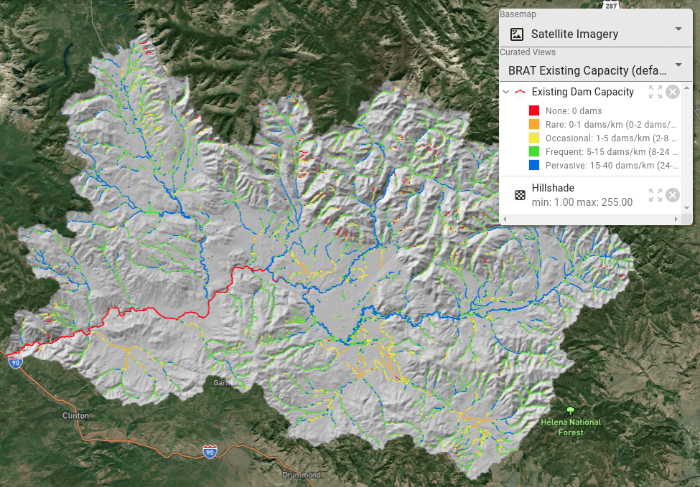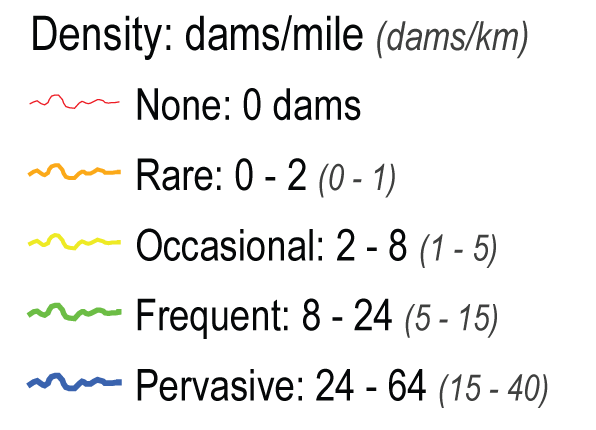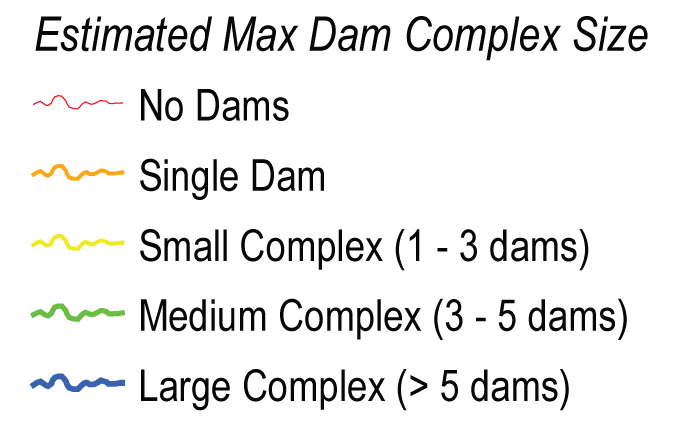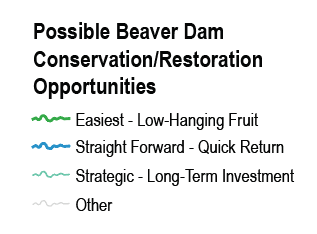Working with BRAT Outputs
The majority of users of BRAT will not actually run BRAT themselves, but instead will download BRAT outputs and summary products for use in beaver-related stream conservation and restoration efforts. In the text and videos tutorials below, we walk through various ways to interact with the BRAT outputs. We cover each of the outputs that BRAT produces, provide lookup tables for investigative purposes, and provide illustrative videos to help access and interrogate the outputs.
The BRAT Default Symbology
The sections below describe the curated BRAT outputs that are visualized by default using the legends shown. The field within the attribute table that is used to symbolize the particular output is shown in parentheses after the output description.

Capacity Outputs
The capacity output layers include outputs that describe:
- existing capacity for beaver dam density (
oCC_EXfield) - historic capacity for beaver dam density (
oCC_HPEfield) - existing potential complex size (
mCC_EX_CTfield) - historic potential complex size (
mCC_HPE_CTfield)
Existing and Historic Capacity
The capacity model produces two values for each stream segment: the density of dams that the segment can support now, and the density of dams that it could support historically. For display, these values are binned and symbolized using the color scheme below (note, while the outputs are binned for display, each ~300 m reach has a specific continuous dam density output). Within the attribute table of the stream network output, the existing capacity value is found in the oCC_EX field and historic capacity is found in the oCC_HPE field. These values represent modeled beaver dam capacity as dams per kilometer or mile for the stream network segment.

Dam Complex Size
In addition, the capacity outputs and reach lengths were used to report estimated dam complex size mCC_EX_CT (for existing) and mCC_HPE_CT (for historic) fields in the attribute table. This is a modeled maximum number of the dams on that particular segment of the stream network. The following color scheme is used to illustrate these outputs:

Management Outputs
The management output layers include outputs that describe:
- the limiting factors which contribute to unsuitable or limited beaver dam opportunities (
LimitationID&Limitationfields in the attribute table) - risk categories which are based on land use and anthropogenic proximity (
RiskID&Riskfields) - a measure of the effort exhibited to perform restoration or conservation in the segment (
OpportunityID&Opportunityfields)
Unsuitable or Limited Beaver Dam Opportunities
(Limitation) Identifies areas where beaver cannot build dams now, and also differentiates stream segments into anthropogenically and naturally limited areas. The logic for this output combines comparisons of existing and historic dam building capacity with slope and drainage area thresholds to determine potential limitations to dam building. The following color scheme is used to illustrate these distinctions:
(THIS LEGEND NEEDS TO BE UPDATED)
Risk of Undesirable Dams
Risk provides a conservative estimate of risk of dam building activity to human infrastructure. The model calculates the distance from each stream segment to the nearest of various types of infrastructure (roads, railroads, canals, etc.), which are represented as geospatial inputs. This information on proximity to infrastructure is combined with dam building capacity outputs and land use in the riverscape surrounding each segment to estimate the potential risk that could result from dam building activity based on the logic presented here.
(THIS LEGEND NEEDS TO BE UPDATED)
Restoration or Conservation Opportunities
(Opportunity) identifies levels of effort required for establishing beaver dams on the landscape. This output is based on comparison between historic and existing dam building capacity, the risk of undesirable dams, and the land use in the riverscape surrounding stream segments based on this model logic.
(THIS LEGEND NEEDS TO BE UPDATED)
The BRAT Attribute Table
This section lists and describes all of the attributes associated with network segments after BRAT has been run.
Channel Network Output (vwReaches)
| Field | Plain English Name | Units | Description |
|---|---|---|---|
| ReachCode | Stream Flow Type | NA | The NHD FCode integer that describes the flow type of a flowline (e.g., perennial, intermittent) |
| StreamName | Stream Name | NA | The stream name according the NHDPlusHR dataset |
| NHDPlusID | Unique ID | NA | A unique identifier from the NHDPlusHR dataset |
| WatershedID | Watershed ID | NA | The 10-digit hydrologic unit code (HUC) of the watershed |
| level_path | NHD Stream ID | NA | A unique identifier from the NHDPlusHR dataset for each unique stream from headwater to outlet |
| ownership | Land Administrator | NA | An abbreviation representing the land administrator of the riverscape associated with the reach |
| divergence | |||
| stream_order | Stream Order | NA | The Strahler stream order of the reach |
| us_state | US State | NA | The US State that the reach falls within |
| ecoregion_iii | Ecoregion III | NA | The EPA Level III ecoregion that the reach falls within |
| ecoregion_iv | Ecoregion IV | NA | The EPA Level IV ecoregion that the reach falls within |
| IsPeren | Is Perennial | Binary | 1 if the reach is perennial, 0 if not |
| iGeo_Slope | Slope | unitless | The reach-averaged slope (m/m) |
| iGeo_Len | Length | m | The length of the reach |
| iGeo_DA | Drainage Area | km2 | The upstream contributing drainage area of the reach |
| iVeg100EX | Existing 100 m Vegetation Suitability | NA | The average vegetation suitability (0-4) of existing vegetation within 100 m of the stream |
| iVeg_30EX | Existing 30 m Vegetation Suitability | NA | The average vegetation suitability (0-4) of existing vegetation within 30 m of the stream |
| iVeg100HPE | Historic 100 m Vegetation Suitability | NA | The average vegetation suitability (0-4) of historic vegetation within 100 m of the stream |
| iVeg_30HPE | Historic 30 m Vegetation Suitability | NA | The average vegetation suitability (0-4) of historic vegetation within 30 m of the stream |
| iPC_Road | Distance to Nearest Road | m | The distance from the stream reach to the nearest road |
| iPC_RoadX | Distance to Nearest Road Crossing | m | The distance from the stream reach to the nearest road crossing |
| iPC_RoadVB | Distance to the Nearest Road in the Valley | m | The distance from the stream reach to the nearest road within the valley bottom |
| iPC_Rail | Distance to the Nearest Railroad | m | The distance from the stream reach to the nearest railroad |
| iPC_RailVB | Distance to the Nearest Railroad in the Valley | m | Distance from the stream reach to the nearest railroad within the valley bottom |
| iPC_LU | Land Use Intensity | NA | The average land use intensity (0-100) within the riverscape associated with the stream reach |
| iPC_VlowLU | Very Low Land Use Intensity | unitless | The proportion of the riverscape associated with the stream reach with very low land use intensity |
| iPC_LowLU | Low Land Use Intensity | unitless | The proportion of the riverscape associated with the stream reach with low land use intensity |
| iPC_ModeLU | Moderate Land Use Intensity | unitless | The proportion of the riverscape associated with the stream reach with moderate land use intensity |
| iPC_HighLU | High Land Use Intensity | unitless | The proportion of the riverscape associated with the stream reach with high land use intensity |
| iHyd_QLow | Low Flow Discharge | ft3/s | The estimated low flow discharge |
| iHyd_Q2 | Typical Flood Discharge | ft3/s | The estimated 2-year recurrence interval flow discharge |
| iHyd_SPLow | Low Flow Stream Power | w | The stream power associated with the low flow discharge |
| iHyd_SP2 | Flood Flow Stream Power | w | The stream power associated wtih the 2-year recurrence interval flood discharge |
| oVC_HPE | Historic Vegetation Capacity | km-1 | Dams per kilometer that the historic vegetation could support |
| oVC_EX | Existing Vegetation Capacity | km-1 | Dams per kilometer that the existing vegetation could support |
| oCC_HPE | Historic Dam Capacity | km-1 | Dams per kilometer that the stream could support historically |
| mCC_HPE_CT | Historic Dam Count | # | The number of dams the stream reach could support historically |
| oCC_EX | Existing Dam Capacity | km-1 | Dams per kilometer that the stream could support currently |
| mCC_EX_CT | Existing Dam Count | # | The number of dams the stream reach current currently support |
| LimitationID | Limitation ID | NA | An identifier for the reach dam building limitation type |
| RiskID | Risk ID | NA | An identifier for the reach risk of conflict with infrastructure category |
| OpportunityID | Opportunity ID | NA | An identifier for the reach conservation/restoration opportunity category |
| iPC_Canal | Distance to Nearest Canal | m | The distance from the stream reach to the nearest canal |
| iPC_DivPts | Distance to Nearest Diversion | m | The distance from the stream reach to the nearest stream diversion point |
| iPC_Privat | Distance to Private Land | m | The distance from the stream reach to the nearest private land |
| oPC_Dist | Distance to Nearest Infrastructure | m | The distance from the stream reach to the nearest infrastructure |
| IsMainCh | Is the Main Channel | binary | 1 if the stream reach is the main channel, 0 if it is a side channel/anabranch |
| IsMultiCh | Is Multi-Channel | binary | 1 if there are multiple channels associated with the stream reach, 0 if not |
| mCC_HisDep | Difference From Historic Dam Count | # | The difference between the number of dams that the reach could historically support and what it currently can |
| Dam_Setting | Dam Setting | NA | Classic, Steep, or Floodplain dam setting type |
| ReachType | Reach Type | NA | A description of the ReachCode field |
| Limitation | Dam Building Limitation | NA | Dam building limitation type for the reach |
| Risk | Dam Risk | NA | The categorical value of risk of dam building conflict with infrastructure |
| Opportunity | Restoration/Conservation Opportunity | NA | Categories describing potential opportunties for beaver-based conservation/restoration strategies |

